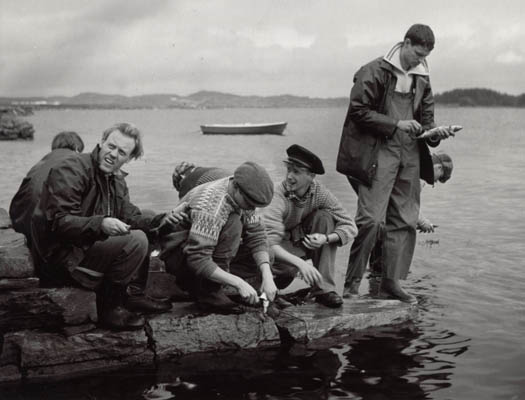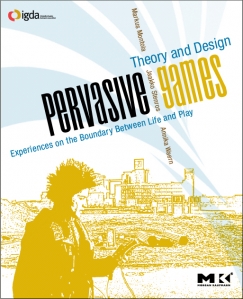Every larp design, and the activity of designing larps itself, can be divided into two inseperable halves: (1) the system or procedure, which I’ll call “frame”, and (2) the components or unique elements inside the system, which I’ll call “canvas”.
Category Archives: Theory
Does Larp Design Matter? (Nordic Larp Talks 2014, video + transcript)
(video courtesy of Nordic Larp Talks)
Full text and images: Continue reading Does Larp Design Matter? (Nordic Larp Talks 2014, video + transcript)
Elements of Larp Design (video + slides)
What is it larp designers actually design? Watch me try to answer this, and other hot-button questions of immediate practical concern in this 45-minute talk I did at Knutpunkt 2014.
Continue reading Elements of Larp Design (video + slides)
Dealing with the Aristotelian Curse
Or: why can it be so difficult to achieve a satisfying conclusion to a larp, and what can we do to change that?

Aristotle (Greek philosopher) was the first to describe the structure underlying most dramatic storytelling. It goes like this: Continue reading Dealing with the Aristotelian Curse
Dark Empathy
One of the traditional claims about (live) role-playing is that it increases empathy, our ability to feel what others feel, to effortlessly experience the world through other peoples eyes.
This claim is supported by plenty of anecdotal evidence, and no real evidence. It makes sense, though.
Continue reading Dark Empathy
Does your larp have a zombie?
Imagine two larps: the first one is about angsty teenagers figuring out the meaning of life in a remote mountain cabin. The second one is exactly the same, except those teenagers are being atacked by zombies. Which larp do you think will attract more players?
In “Talk Larp”, one of the three downloadable anthologies published at the 2011 Knudepunkt conference, Juhana Pettersson’s contribution “The Necessary Zombie” contains two very useful observations:
Continue reading Does your larp have a zombie?
Tips & Traps
I came across this excellent gathering of advice in Swedish on Gabriel Widings blog, and impulsively translated it into English. Gabriel is one of the authors of the book-slash-provocation deltagarkultur (“participatory culture”) and has spent as much time working with ARGs, collaborative writing and other kinds of participatory culture as he has with larp. So the list below includes but is not limited to the design of live-roleplaying events.
I think it pinpoints precisely how to avoid the mistakes that are usually comitted by people in the Established Arts (theatre, cinema, performance etc.) who try to engage their “audiences” in interactivity or participation, and it also offers up some eternal larpwriting truths. As with most holy text, there is space here for both interpretation and heresy.

Tips and traps when making participatory culture
By Gabriel Widing
Tips:
- Communicate the agreement clearly and explicitly. Only when the participant knows the rules of play, that is: how communication and participation are meant to be done, is she confident enough to act.
- Consider banning passive spectators and documentation. The external, critical, view is not always productive. It may in some cases prevent participatory action. People do not behave the same way in front of a camera as they do in front of confidantes. Documentation usually fails at capturing the qualities of a participatory work, but easily pushes participants from dialogic action to simple performance.
1942 & The Three Affiliations Model
So it’s been a hiatus. My main excuse is that my larp writing energy has gone into a) a larp (Marcellos Kjeller, pics, to be blogged) and b) an article about the larp “1942 – noen å stole på” (FLH, 2000) for the forthcoming Nordic Larp book project. A fiendishly difficult writing project, as the article was to be less than 2000 words. Brevity is not my strong side.

While researching “1942”, a canonical 5-day 130-player larp held on Norway’s west coast back in 2000, I was reminded of the “Three Affiliations” model the 1942 organizers used to provide activities and relationships for their characters. The model was successful enough that it has later been reused for similar Norwegian larps – larps that focus on the living of daily life in smallish communities.
Continue reading 1942 & The Three Affiliations Model
[book review] Pervasive Games – theory and design
(this is the English text of a review published in Finnish translation in issue #23 of Roolipelaaja magazine)
Markus Montola, Jaakko Stenros, Annika Waern:
Pervasive Games – Theory and Design
 This book is important. For years, people have been playing different kinds of games that occur in public spaces, that mix play with reality and players with unwitting civilians, that can invade your life at any time and any place. Some of these should be familiar to role-players: games such as “Killer”, where you murder your friends with bananas, or the “city larp”, played on the streets, in the cafes, amongst non-larpers. Others, such as “Alternate Reality Games” (ARGs) or location-aware mobile games, have their origins in business and marketing. Yet others, such as zombie walks or flash mobs, seem to have exploded out of the creative stew of the Internet. Continue reading [book review] Pervasive Games – theory and design
This book is important. For years, people have been playing different kinds of games that occur in public spaces, that mix play with reality and players with unwitting civilians, that can invade your life at any time and any place. Some of these should be familiar to role-players: games such as “Killer”, where you murder your friends with bananas, or the “city larp”, played on the streets, in the cafes, amongst non-larpers. Others, such as “Alternate Reality Games” (ARGs) or location-aware mobile games, have their origins in business and marketing. Yet others, such as zombie walks or flash mobs, seem to have exploded out of the creative stew of the Internet. Continue reading [book review] Pervasive Games – theory and design
Understanding live role-playing / theory 101
To bind a demon, you must know its name.
How are we to design larps, to teach and talk about larp design, if we are unable to talk about how larp works, what goes on when people role-play? A lot of larps are designed and played almost unconsciously. Yes, we know how to play, we also, for the most part, know how to design. But when people ask “how?” we resort to simplistic metaphor and simile – “like cowboys and indians with adults!”, “like theatre, but without an audience!”, “like the plot at last years summer larp, but with dark elves instead of orcs”… Continue reading Understanding live role-playing / theory 101
